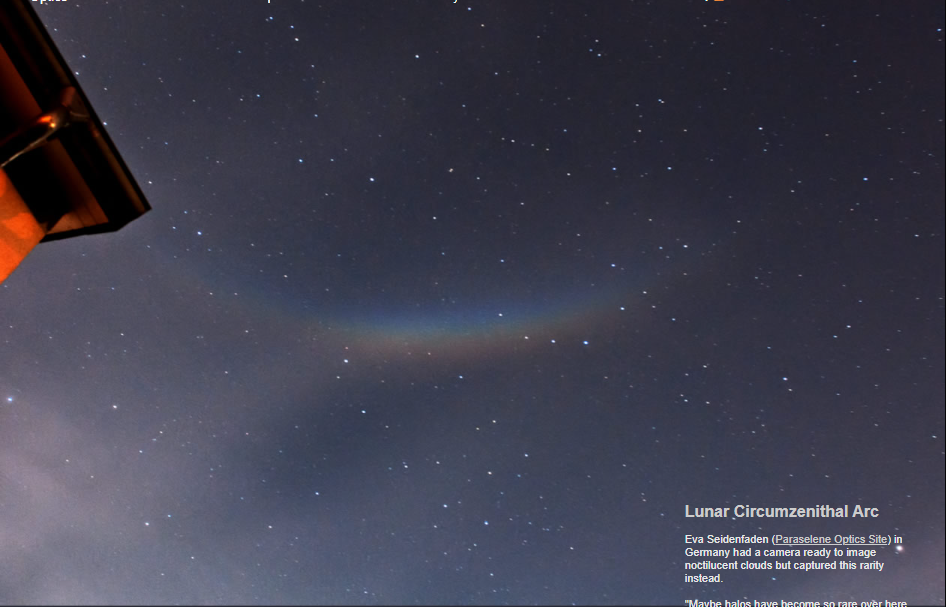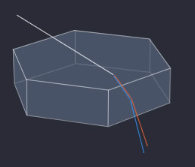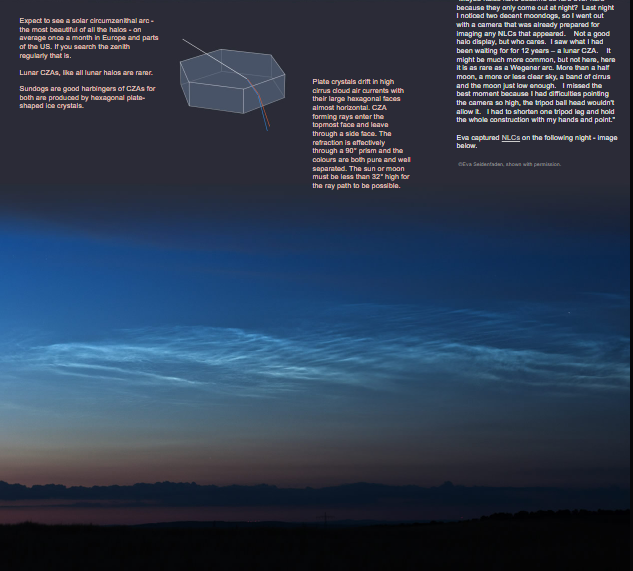OPOD - Lunar Circumzenithal Arc
OPOD - Lunar Circumzenithal Arc: A Rare Atmospheric Phenomenon
Have you ever gazed at the night sky and witnessed a celestial spectacle that left you in awe? Eva Seidenfaden, a passionate sky observer from Germany, experienced just that. While waiting to capture images of noctilucent clouds (NLCs), she stumbled upon a rarity known as a lunar circumzenithal arc (CZA). This captivating phenomenon, often overshadowed by its solar counterpart, is a sight to behold. Let's delve into the details of this atmospheric optics wonder and explore its elusive nature.
The Elusive Lunar CZA
Eva Seidenfaden's unexpected encounter with a lunar CZA highlights its rarity, particularly in certain regions. While solar circumzenithal arcs can be observed approximately once a month in Europe and parts of the United States, lunar CZAs are even scarcer. These ethereal displays occur when specific atmospheric conditions align, making them a cherished find for sky enthusiasts.
Hexagonal Ice Crystals and CZAs
To understand the formation of lunar CZAs, we must first explore the role of hexagonal plate-shaped ice crystals. These crystals play a crucial role in the creation of various atmospheric halos, including sundogs and CZAs. As these plate crystals drift in high cirrus cloud air currents, their large hexagonal faces align horizontally.
The Mechanics of CZA Formation
The mesmerizing colors and pure separation of a lunar CZA are a result of the refraction of light through the hexagonal ice crystals. When rays of light enter the topmost face of a plate crystal and exit through a side face, they undergo refraction through a 90° prism-like structure. This unique refraction creates the distinct and vivid colors that characterize lunar CZAs.
Optimal Conditions for Lunar CZA Observation
To witness the enchanting display of a lunar CZA, certain conditions must align. The moon must be positioned at an angle of less than 32° above the horizon, allowing for the necessary ray path to form. Additionally, a band of cirrus clouds in a relatively clear sky enhances the visibility and contrast of the lunar CZA against the night sky.
The Quest for Capturing Lunar CZAs
Eva Seidenfaden's experience highlights the challenges and dedication required to capture elusive atmospheric phenomena like lunar CZAs. In her case, difficulties in pointing the camera at such a high angle led to a missed opportunity to capture the peak moment of the lunar CZA. Nonetheless, her perseverance and passion for sky observation allowed her to capture stunning images of NLCs on subsequent nights.
Appreciating the Beauty of Atmospheric Optics
Atmospheric optics never fails to mesmerize with its array of captivating phenomena. From the shimmering colors of sundogs to the rare elegance of lunar CZAs, these displays remind us of the intricate beauty that surrounds us. By observing and documenting these phenomena, individuals like Eva Seidenfaden contribute to our understanding and appreciation of the wonders present in our atmosphere.
In conclusion, the discovery of a lunar circumzenithal arc by Eva Seidenfaden provides a glimpse into the elusive world of atmospheric optics. Lunar CZAs, although rarer than their solar counterparts, captivate observers with their vibrant colors and unique formations. As we continue to explore and document these atmospheric wonders, we deepen our understanding of the celestial spectacle that unfolds above us each day and night.

Lunar Circumzenithal Arc
Eva Seidenfaden (Paraselene Optics Site) in Germany had a camera ready to image noctilucent clouds but captured this rarity instead.
"Maybe halos have become so rare over here because they only come out at night? Last night I noticed two decent moondogs, so I went out with a camera that was already prepared for imaging any NLCs that appeared. Not a good halo display, but who cares. I saw what I had been waiting for for 12 years – a lunar CZA. It might be much more common, but not here, here it is as rare as a Wegener arc. More than a half moon, a more or less clear sky, a band of cirrus and the moon just low enough. I missed the best moment because I had difficulties pointing the camera so high, the tripod ball head wouldn't allow it. I had to shorten one tripod leg and hold the whole construction with my hands and point."
Eva captured NLCs on the following night - image below.
©Eva Seidenfaden, shown with permission.

Expect to see a solar circumzenithal arc - the most beautiful of all the halos - on average once a month in Europe and parts of the US. If you search the zenith regularly that is.
Lunar CZAs, like all lunar halos are rarer.
Sundogs are good harbingers of CZAs for both are produced by hexagonal plate-shaped ice crystals.
Plate crystals drift in high cirrus cloud air currents with their large hexagonal faces almost horizontal. CZA forming rays enter the topmost face and leave through a side face. The refraction is effectively through a 90° prism and the colours are both pure and well separated. The sun or moon must be less than 32° high for the ray path to be possible.

Note: this article has been automatically converted from the old site and may not appear as intended. You can find the original article here.
Reference Atmospheric Optics
If you use any of the definitions, information, or data presented on Atmospheric Optics, please copy the link or reference below to properly credit us as the reference source. Thank you!
-
<a href="https://atoptics.co.uk/blog/opod-lunar-circumzenithal-arc/">OPOD - Lunar Circumzenithal Arc</a>
-
"OPOD - Lunar Circumzenithal Arc". Atmospheric Optics. Accessed on December 28, 2024. https://atoptics.co.uk/blog/opod-lunar-circumzenithal-arc/.
-
"OPOD - Lunar Circumzenithal Arc". Atmospheric Optics, https://atoptics.co.uk/blog/opod-lunar-circumzenithal-arc/. Accessed 28 December, 2024
-
OPOD - Lunar Circumzenithal Arc. Atmospheric Optics. Retrieved from https://atoptics.co.uk/blog/opod-lunar-circumzenithal-arc/.